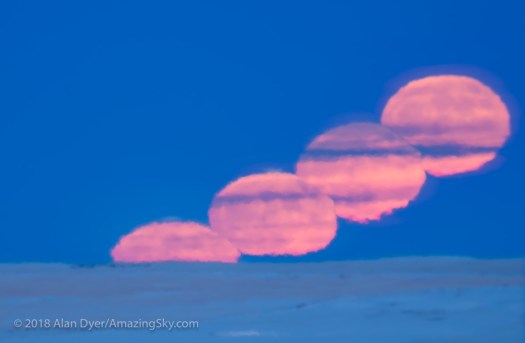
Happy New Year to all!
New Year’s Day proved to be a busy one for sky sights from home in southern Alberta.
Clear skies and warming temperatures allowed me to capture a trio of sights on January 1: Mercury in the morning, a unique mirage called the Fata Morgana in the afternoon, and the rising Full Moon in the evening.
On January 1 elusive Mercury was at its greatest elongation away from the Sun in the morning sky. This placed it as high as it can get above the horizon, though that’s not high at all at the best of times.

I captured Mercury before dawn as a bright star in the colourful twilight, using a telephoto lens to frame the scene more closely.
At this time the temperature outside was still about -24° C, as a cold snap that had plunged the prairies into frigid air for the last week still held its grip.
But by the afternoon, warmer air was drifting in from the west, in a Chinook flow from the Rockies.
As evidence of the change, the air exhibited a form of mirage called the Fata Morgana, named after the sorceress Morgan le Fay of Arthurian legend. The illusion of castles in the air was thought to be a spell cast by her to lure sailors to their doom.

The mirage produced the illusion of bodies of water in the distance, plus distorted, elongated forms of wind turbines and farm buildings on the horizon. The cause is the refraction of light by layers of warm air aloft, above cold air near the ground.
By evening the mirage effect was still in place, producing a wonderful moonrise with the Full Moon writhing and rippling as it rose through the temperature inversion.
As the lead image at top shows, at moments the top of the disk had a green rim (almost a distinct green flash), while the bottom was tinted red.
Here’s a short time-lapse video of the scene, shot through a small telescope. The lead image above and below is a composite of four of the frames from this movie.

This was also the largest and closest Full Moon of the year, what has become popularly called a “supermoon,” but more correctly called a perigean Full Moon.
A lunar cycle from now, at the next Full Moon, the Moon undergoes a total eclipse in the dawn hours of January 31 for western North America. This will be another misnamed Moon, a “blue Moon,” the label for the second Full Moon in a calendar month.
And some will also be calling it a “supermoon,” as it also occurs close to perigee – the closest point of the Moon to Earth in its monthly orbit – but not as close a perigee as it was at on January 1.
So it will be less than super, but it will nevertheless be spectacular as the Full “blue” Moon turns red as it travels through Earth’s shadow.
— Alan, January 2, 2018 / © 2018 Alan Dyer / amazingsky.com

